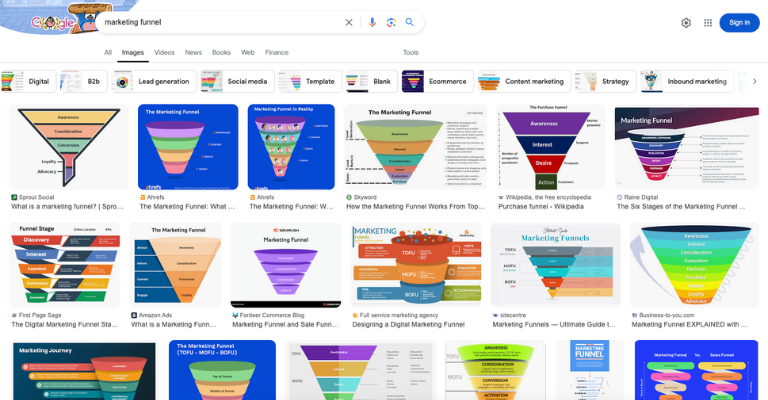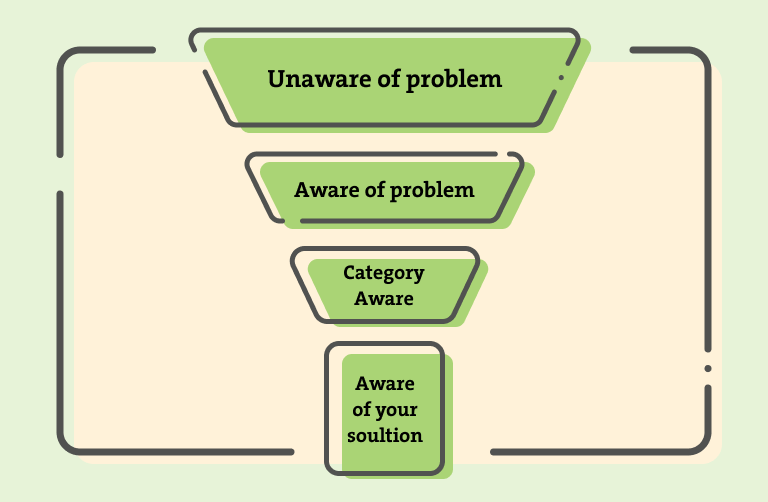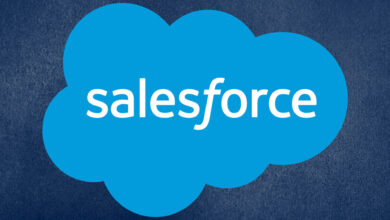Is there a real marketing funnel?

THE Marketing funnel– that cute little brightly colored cone that’s supposed to make your life easier, but it really doesn’t. If you are a marketer and don’t understand my previous sentence, you might still find it interesting to learn about marketing funnels from a different perspective.
If you find yourself in the first sentence, this article is definitely written for you. In the rest of the blog, you will discover the only marketing funnel logic you’ll ever need to start creating content. You’ll learn how to tailor your content to the steps your audience begins their journey with. And you won’t be left out of the equation. You’ll love the part where this content will actually work for you.
Shapes, colors and chaos
If you Google “marketing funnel,” you might understand a little better what I’m talking about. There is hundreds of versions of the samebrightly colored and divided into different stages. They especiallyIt’s the same thing in different ways, but in some cases they even contradict each other.
If you look at them carefully, you will find that some suggest preparing one type of content for the first step, while others for the third. Additionally, while some stick to the three- or four-step funnel, some go as high as ten or even more. Their visual representations differ, so they may not even be cone-shaped. There are different versions of the funnel for content writing, social media marketing, ad creation and targeting, and more. Although you will actually do different things for each of the previously mentioned processes, it is important to first understand the basic logic, and then you will be able to apply the principles anywhere. There is no need to have hundreds of versions of the funnel.

Source: Google
When it comes to writing, do these funnels indicate what you should actually be doing? Most of them don’t. This is very important if you are a junior marketer or marketer who is not very familiar with funnel logic. The first phase, whether called awareness or discovery, usually tends to clearly suggest what your first step should be. But once you dig deeper, it’s easy to get lost, especially if the funnel has ten steps with confusing names and definitions.
Did we really have to go there and complicate things that much? I would say no. When you understand the basic logic of the marketing funnel, a single version is more than enough to guide your process. Otherwise, it just adds to the confusion.
A Simple Marketing Funnel
A few months ago, I listened to a marketing course given by Cover the Fraser. Among the introductory lessons, I came across a 7-minute lesson on the marketing funnel. His version of the marketing funnel is a modification of the funnel explanation discussed in the book Breakthrough Advertising by Eugene M. Schwartz. As I listened to this explanation, I started thinking that I have never heard such a simple yet useful explanation of a marketing funnel before. To understand the topic well, I have read the book and summarized some of the examples mentioned in the book for your better understanding. My understanding of these two explanations is written below. Let’s get straight to the point.

Source: Marketing Course by Dekker Fraser
Although some people are logical prospects for your product, in their own minds they might be miles away from accepting this product. Each of these stages is separated from the others by a psychological wall. Content that works for the first stage will not work for the fourth stage: in the first stage, the customer is indifferent, while in the last stage, he is keenly interested in the product.
Step One: Ignore the Problem
So, let’s start with the first step: your the potential customer is unaware of the problem. If we reach the hardest position in this stage, your product or service is so far ahead that the need for it does not exist. This kind of situation happened to Apple when they released their computer, Apple 1. Before Apple’s efforts, computers were primarily large, expensive machines used by businesses, government institutions, and universities. The idea of a personal computer for individual use was not widely accepted or understood. Their vision and innovation helped demonstrate the potential of personal computers, ultimately leading to their widespread adoption as we know it today.
However, many products are designed to satisfy a real need or want, so they will never face the problem of an unconscious market. If we step out of this extreme, we can talk about a situation at this stage that happens more often: your customers are unaware of the problem they are having and your solution that could benefit them. This means that potential customers are unaware that they might be wasting time and money, or that they go about their daily lives without realizing that something could be better or easier.
Let’s say you are a merchant selling pillows and mattresses. Imagine a potential customer who has trouble sleeping well but hasn’t considered that something they are doing or using might be the problem. They experience discomfort, but they attribute it to the fact that it is simply a normal part of aging. In stages like this, using your product specifications or price as bait for potential customers simply won’t work. This is why you must work on their education.
Content at this stage should focus on educate the public about the problem. For example, a blog post titled “5 Signs You’re Not Getting Enough Sleep” or “Why Do You Feel Tired All the Time?” It might not be what you think” might help the reader realize they have a problem with sleep quality. Right after presenting this, there might be a solution that could help them stop losing sleep: they would be ready to move on to a second step. If you still don’t know what to write, you can always ask our dear friend ChatGPT:
“Act like a content marketer who needs to come up with ten suggestions for a blog/social media post about __ (product) that targets potential customers in the first phase of a marketing funnel where they are unaware of the problem they are experiencing. “
I’m sure he’ll come up with some good ones that will help you get creative.
Step two: become aware of the problem
Let’s move on to the second step. Your potential customer now recognizes that they have a sleep problem but I haven’t considered a specific solution yet.. They could start researching the problem and seeking information to understand it better. Realizing that poor sleep affects their health and productivity, they begin to seek information on how to improve sleep quality. At this point, you focus on helping the customer understand the problem more deeply.
Content might include articles like “How a Bad Mattress Can Ruin Your Sleep” or quizzes like “Is Your Mattress Keeping You from Sleeping?” ” that get the customer to connect their problem to a potential solution. This step is purely a problem-solving step in which your task is to name a problem your potential customer is having and then present your product category as an inevitable solution. In either of the first two phases, your customers are not ready to make a purchase. That’s why your call to action should guide them to continue learning about their problem and possible solutions and postpone the sale until later stages.
Third step: taking categories into account
Arriving at the third phase, your customer knows that there are categories of solutions that can solve their problem but has not yet chosen a specific brand or product type. They are exploring different options within the category. This means that your potential customer has discovered that the cause of their problem lies in mattresses and they are starting to research different types of mattresses (e.g. memory foam, innerspring, hybrid). Your content should focus on the benefits of the product type and help the customer compare options. For example, you can provide comparison guides such as “Memory Foam or Innerspring Mattresses: Which is Right for You?” » or educational videos on the benefits of each type. When your customer finally decides which option best meets their needs, it’s a good time to explain why they should buy from you instead of everyone else.
Step Four: Know Your Solution
And that brings us to the fourth and final step. The customer is aware of your specific product or service and is considering buying it. They evaluate your offering against your competitors and decide if it’s the right choice. Here the emphasis is on convince the customer that your product is the best solution. This might involve highlighting unique selling points, offering customer testimonials, or offering a special discount. The main thing you need to accomplish during this phase is to differentiate your product from others, which will determine the customer’s purchasing decision. In previous pages, customers weren’t ready to make a purchase, but at this point, the time is right. To demonstrate why they should choose your product, create content that will convince customers to buy from you:
Service pages/landing pages Customer testimonials and case studies Product demos Social proof Frequently asked questions
In this phase, the content must be very targeted and compellingresponding to any remaining objections and encouraging the final decision to purchase your product or service.
One last thing to consider
While the marketing funnel provides a clear path from awareness to purchase, it’s essential to remember that every customer is unique. They bring different levels of knowledge and awareness to your online store, meaning they can enter the funnel at different stages.
By understanding and meeting the specific needs of each stage, you can guide each potential customer to the best solution: your product or service. Your goal is to create a seamless experience who meets them wherever they are on their journey. Whether they’re just discovering their problem or ready to make a decision, make sure your content supports and guides them every step of the way.



